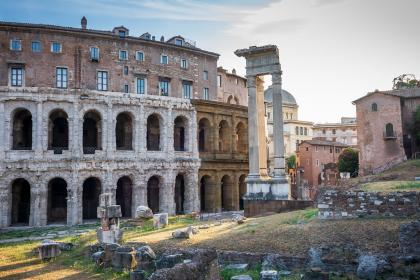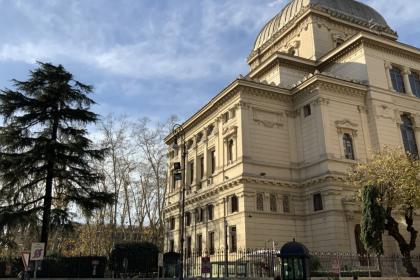
The remains of the three temples stand in the Sant'Angelo district, near Piazza Venezia, where the church of San Nicola in Carcere is now located. In this area there was the Foro Olitorio - Forum Holitorium - the square where the vegetable market was located not far from the river port. The remains of the porticoes with tabernae visible in front of the church remain today from this commercial area. What remains of the three temples of the Republican period is located under the church and on the sides of the latter.
The southern temple, of Doric order, is thought to have been dedicated to the goddess Spes, or Hope, and was the smallest. Built during the First Punic War by the consul Atilio Calatino in 254 BC, it was restored and rebuilt several times over the centuries. The temple retains only six columns incorporated into the southern wall of the church.
The remains of a second temple, probably the most recent and largest of the three, are visible in the basement of the church, near the apse; some columns of the front part also remain. It was of Ionic order and had six columns on the front. The temple was probably dedicated to Juno Sospita, protector of births. Built in the early 2nd century BC. C. by the consul Cornelio Cetego, it was restored in the Augustan and Hadrian periods.
The third temple, the northernmost of the three, is also the best preserved; it is currently located on the right of San Nicola in Carcere. All the podium and part of the colonnade remain of this; it was of Ionic order, with a triple row of six columns on the front. The sacred building, preceded by a flight of steps, was perhaps dedicated to the god Janus and was built by the consul Caio Duilio during the first Punic war. Rebuilt at the beginning of the 1st century BC, this temple too was restored several times, in the Augustan, Tiberian and Hadrian periods.
Photo credits: courtesy of the Capitoline Superintendency for Cultural Heritage
Basílica de San Nicolás en Cárcel

 Condividi
Condividi
El Teatro Marcelo

 Condividi
Condividi
Antiguo Barrio Judío

 Condividi
Condividi
Informaciones
 Condividi
Condividi
Location
Para conocer todos los servicios de accesibilidad, visite la sección Roma accesible.











































